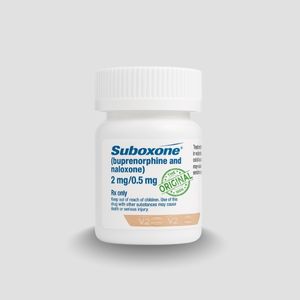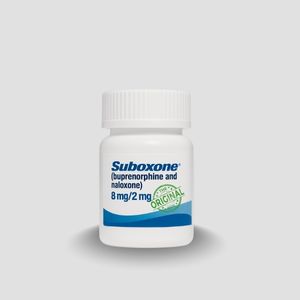Buy Suboxone Online
Showing all 2 results
-
$306.00
-
$326.00
What is Suboxone?
Suboxone is a brand-name drug that contains buprenorphine and naloxone as active ingredients. Buprenorphine is an opioid medication, sometimes called a narcotic. Naloxone helps in blocking the effects of opioid medication, including pain relief or feelings of well-being that can lead to opioid abuse. Suboxone helps treat narcotic addiction and is not for use as a pain medication. Suboxone is a prescription drug that helps people who are addicted to opioids. You can order Suboxone online with a prescription. Suboxone comes as an oral film applied under the tongue (sublingual) or between the gums and cheeks. The film dissolves in your mouth. Suboxone contains two drugs in each film: buprenorphine and naloxone. It is available in four strengths:
- 2 mg buprenorphine/ 0.5 mg naloxone
- 4 mg buprenorphine/ 1 mg naloxone
- 8 mg buprenorphine/ 2 mg naloxone
- 12 mg buprenorphine/ 3 mg naloxone
Important Information
Suboxone may be habit-forming and can slow or stop your breathing. Misuse of Suboxone can cause addiction, overdose, or death, especially if the medication is being used without a prescription by people. Using Suboxone during pregnancy may cause life-threatening withdrawal symptoms in the newborn. If you combine this medicine with alcohol or other drugs that cause drowsiness or slow your breathing, fatal side effects can occur.
What to know before taking Suboxone?
Do not use Suboxone if you are allergic to buprenorphine or naloxone. To make sure Suboxone is safe for you, tell your doctor if you have any of the following conditions:
- breathing disorders such as sleep apnea
- enlarged prostate, urination problems
- liver disease
- kidney disease
- abnormal curvature of the spine that affects breathing
- problems with your gallbladder, adrenal gland, or thyroid
- a head injury, brain tumor, or seizures
- alcoholism or drug addiction
If you use Suboxone while pregnant, your baby may develop a dependency on it, causing life-threatening withdrawal symptoms in the baby after it is born. If you are breastfeeding, consult a doctor before taking Suboxone. Call your doctor if you notice symptoms such as drowsiness or slow breathing in a nursing baby.
How to take Suboxone?
Use Suboxone as prescribed by your doctor. Read all medication guides and follow the directions on your prescription label. Suboxone should not be used in larger doses or for longer than recommended. Tell your doctor if you have an increased urge to use more of this medicine. Drink water to moisten your mouth before using a Suboxone sublingual film. This helps the film dissolve more easily. Place one film to the inside of your right or left cheek. If your doctor advises you to take two films at once, place one on the inside of one cheek and the other on the inside of the other cheek.
Do not chew or swallow the film while it dissolves because the medicine will not work either. Place Suboxone sublingual tablets under the tongue until they dissolve. Never give Suboxone to anyone else, especially someone with a history of drug addiction or abuse. Addiction, overdose, or death can result from misuse. Keep the medicine in a secure location where others cannot access it. It is illegal to sell or give Suboxone away. You should always buy Suboxone online from a trusted website. If you switch between them, you may not use the same dose for each buprenorphine-containing medicine.
If you suddenly stop taking Suboxone, you may experience unpleasant withdrawal symptoms. Inquire with your doctor about how to safely stop taking this medication. To monitor your liver function, you will need to have blood tests on a regular basis. You should inform all of your medical providers that you are receiving treatment for opioid addiction and are using Suboxone. Do not crush or break a Suboxone sublingual tablet to inhale the powder or dissolve it in a liquid to inject it into your vein. Doing so may lead to death.
Suboxone should be kept at room temperature, away from heat and moisture. Keep a record of your medications. You should be aware if someone is misusing it or using it without a prescription. Do not keep leftover opioid medication. A single dose of this medicine can be fatal if taken incorrectly or accidentally.
Suboxone dosage
Adult Dose for Opioid Dependence – Induction:
To avoid precipitating an opioid withdrawal syndrome, initial doses should begin when objective signs of moderate opioid withdrawal appear and not less than 6 hours after the patient last used opioids.
Suboxone Sublingual Film:
Day 1: Take up to 8 mg/2 mg sublingually; administer as an initial dose of 2 mg/0.5 mg or 4 mg/1 mg with titration in 2 or 4 mg increments of buprenorphine at approximately 2-hour intervals Day 2: Take a single dose of 16 mg/4 mg sublingually
Overdose
An opioid overdose can be lethal, especially in a child or other person using the medicine without a prescription. The overdose symptoms may include severe drowsiness, pinpoint pupils, slow breathing, or no breathing.
What to avoid while using Suboxone?
Do not drink alcohol. Dangerous side effects or death could occur. Do not drive or operate machinery if you do not know how this medicine will affect you. Dizziness or severe drowsiness may lead to falls, accidents, or severe injuries.
Suboxone side effects
The common side effects of Suboxone may include:
- dizziness or drowsiness
- blurred vision, feeling drunk, trouble concentrating
- nausea, vomiting, constipation
- tongue pain, redness, or numbness inside your mouth
- withdrawal symptoms
- headache, back pain
- fast or pounding heartbeats, increased sweating
- sleep problems (insomnia)
This drug may slow or stop your breathing, and death may occur. If you have blue-colored lips, slow breathing with long pauses, or are difficult to wake up, someone caring for you should seek emergency medical attention. Older people are more likely to have serious breathing problems, especially those who are debilitated and those with wasting syndrome or chronic breathing disorders.
Get emergency medical attention right away if you have the following:
- breathing that stops during sleep, weak or shallow breathing
- a light-headed feeling
- loss of coordination, confusion, extreme weakness
- blurred vision, slurred speech
- liver problems – loss of appetite, dark urine, upper stomach pain, clay-colored stools, jaundice
- high levels of serotonin in the body – shivering, fast heart rate, agitation, hallucinations, fever, sweating, muscle stiffness, twitching, loss of coordination, nausea, vomiting, diarrhea
- low cortisol levels – loss of appetite, nausea, vomiting, dizziness, worsening tiredness, or weakness
- opioid withdrawal symptoms – shivering, feeling hot or cold, runny nose, goosebumps, increased sweating, watery eyes, diarrhea, muscle pain
What drugs can interact with Suboxone?
If you start or stop taking some other medications, you may experience breathing problems or withdrawal symptoms. If you are taking antibiotics, antifungal medicines, seizure medication, HIV or hepatitis C medication, or heart or blood pressure medication, tell your doctor. Opioids can interact with many other drugs and cause fatal side effects or death.
Tell your doctor if you also use:
- cold or allergy medicines, bronchodilator asthma, or COPD medication
- medicines for motion sickness, irritable bowel syndrome, or overactive bladder
- other opioids – opioid pain medicine or prescription cough medicine
- a sedative like Valium – diazepam, alprazolam, lorazepam, Xanax, Klonopin, Ativan,etc.
- medications that make you drowsy or slow your breathing – muscle relaxers, sleeping pills, medicines to treat mood disorders or mental illness
- drugs that affect serotonin levels in your body – a stimulant or medicine for depression, Parkinson’s disease, migraine headaches, serious infections, or nausea and vomiting.


